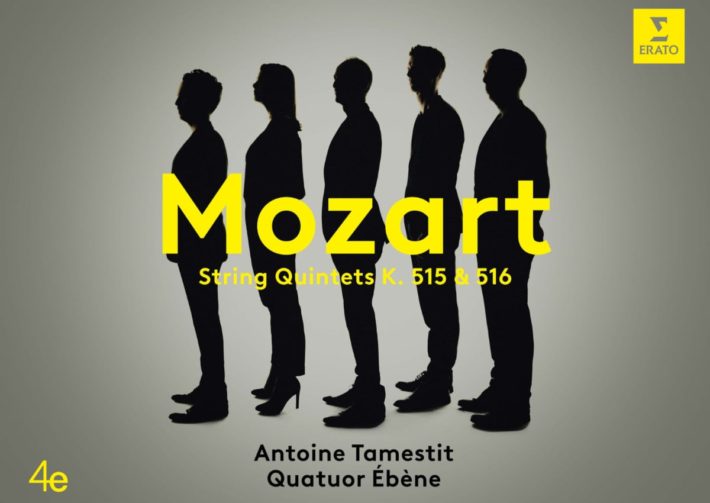Quatuor Ébène’s recent releases show an agile zig-zag across eras: Beethoven in 2019, Dutilleux and Schoenberg in 2021, and now back to Mozart with the K. 515 and K. 516 Quintets. As in their contemporary album, the performers enlist the collaborative help of violist Antoine Tamestit, whom they met at the ARD International Competition back in 2004.
The C major K. 515 Quintet may remind listeners of the K. 465 “Dissonance” Quartet (which the group performed on a 2011 disc). Both first movements find common textural ground: snippets of animated conversation appear against a repeated-note ostinato of inner voices. In the case of the quintet, the dialogue is between the violin and cello. While it’s reasonable to assume the cellist aims not to overpower, the line somehow ends up sounding too cautious with the violin (albeit with fine playing) having most of the say—a shame, given the low string would otherwise add a lovely baritone depth. Conversation is an ongoing theme throughout the work and finds more equal footing in the Menuetto (track 2). Here, voices travel in pairs: the ensemble’s intervallic movement is seamlessly synchronized even in the smallest crescendos; a nice added touch is how each pairing has a different timbre and personality.
The F major Andante is quite lovely, giving the violas their chance to shine. First violist Tamestit comes through with an inviting tone, setting up a charming interchange with the violins, who sound coy and graceful. There is an underlying sensibility to all of this, with the performers steering clear of making things too saccharine.
Related Classical Music Reviews
- Review: Mozart – String Quintets K. 515, 516 – Quatuor Van Kuijk
- Review: Mozart – “Prussian” String Quartets – Doric String Quartet
- Review: ’round midnight – Quatuor Ébène
As on the last album cellist Raphaël Merlin authors the liner notes: in them, he remarks that the G minor quintet (K. 516) is a work of “high drama.” That might well be an accurate description, but the quartet members are a well-oiled machine. Blending between different parts is impeccable, as is a polished, resonant tone from all. Surely this is pleasing to the ear, but more individuality in each line might lend greater depth to the work. The darker mood also calls for more rawness and pathos: for instance, the yearning phrases of 0’31”-0’41 have a want for greater urgency and the sliding dissonances need a twinge of eeriness. The Guarneri Quartet’s account with Steven Tenenbom has verve in the subito fortes; the dissonances, while elegant, definitely send a shiver down our spines.
The second movement Menuetto is a stately, if not austere version of the dance. Ébène grasps this nuanced reservedness nicely via generous space between notes and phrases, a measured tempo, and an elegant tone. But here is where these elements also become a double-edged sword: the downbeats don’t carry enough presence, which consequently doesn’t allow us to appreciate the dance’s lilt. The Amadeus Quartet with Cecil Aronovitz also takes a conservative tempo, but navigates the potential pitfalls with adjustments to phrasing: the sostenuto approach and better downbeats preserve rhythmic integrity but also add wistful lyricism.
The final movement (especially the Adagio section) is where Ébène plays at its best: first violinist Pierre Colombet has excellent bow control throughout, which helps bring out an aching sensitivity in the whispery shades of piano. High drama is reserved for moments like 1’51” onwards, which makes for effective large-scale architecture. This is the sort of intensity and variety of emotion that I had wanted to hear earlier, and that demonstrates the ensemble’s full artistic capabilities. The major-key Allegro (3’00”) comes in like a ray of light: Colombet’s effortless virtuosity in the sweeping runs adds a delightful airiness.
Mozart in any form presents a challenge with its stylistic demands and technical precision–all while needing to sound effortless. These difficulties might be particularly salient in his chamber music, which can be so transparent but also symphonic in its most robust moments. Ébène’s performances here might have their occasional hits and misses but overall, this is a worthy listen for its thoughtful musicality.

Mozart Quintets K. 515 and K. 516
Quatuor Ébène
Antoine Tamestit – Viola
Erato, CD 5419721332
Recommended Comparisons
Read more classical music reviews or visit The Classic Review Amazon store
Follow Us and Comment:
Get our periodic classical music newsletter with our recent reviews, news and beginners guides.
We respect your privacy.









